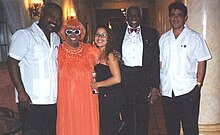Contralto
The alto is the lowest female voice, and stands out for the rich sonority and amplitude of its low register.
This voice is very rare and difficult to find, since only 2% of women in the world have it. In opera, the roles attributed to singers with this vocal range are usually represented by mezzosopranos for their rarity.
Tessitura
It usually ranges from f3 which is below middle C (one octave below middle C) to fa5 (one octave to the right of middle C, with middle C set to C4). The name of central C can vary according to the acoustic index taken as a reference. The scientific sound index is used here, where c4 (261.63 Hz) is considered to be the central note of the piano.
The typical register of a contralto singer varies between fa3 and fa5, but depending on the training that receives the voice the register can be extended descending from mi3 and ascending to B flat 5.
Currently most of the women who sing contralto roles are actually mezzo-sopranos who manage to reach the bass of the contralto by hollowing out their voices and using the female chest, this is due to the infrequency of true contraltos.
Although both men and women can have voices within the contralto vocal range, this term is always used in reference to the female sex. The man who sings in the range of mezzo-soprano or soprano is called a countertenor.
History
The contralto concept is originally linked to singing in classical opera, thus in some cultures they lack a comparative system of vocal categorization, being the term proper to Western traditions and attributable only to female vocalists; male vocalists with a similar vocal range are known as 'countertenors'. The Italian terms "alto" and "high" are not synonymous, the latter technically denoting a specific vocal range in choral singing without regard to factors such as range, timbre, vocal ability, or voice weight.
A true contralto is often considered one of the rarest female voices, present in only a small percentage of the world's population. Some music theorists have discovered that the vocal cords found in these types of singers are thicker than those present in other female voices.
Types of contralto
Within the contralto voice, three generally differentiated subcategories are recognized in the field of opera: coloratura contralto, comic or buffa contralto, and dramatic contralto. These subtypes do not always apply precisely to individual singers; there are some exceptions within the dramatic contraltos such as Ernestine Schumann-Heink and Sigrid Onégin, which are technically capable of interpreting not only strong and dramatic melodies by authors such as Wagner, but can also interpret ornate compositions by authors such as Donizzetti.
Dramatic Contralto
The dramatic contralto is the deepest and darkest voice, frequently having a harder tone and greater vocal power than the rest. It is not usual to find singers in this category.
True contraltos are rare, and the operatic literature has few roles written specifically for them. Contraltos are occasionally cast in female roles such as Teodata in Flavio, Angelina in Cinderella, Rosina in The Barber of Seville, Isabella in The Italian in Algiers, and Olga in Eugene Onegin, but they usually play villainous roles or originally male roles. written for castratis. The contraltos' repertoire abounds in dramatic roles that require great intensity of expression. An example of this is Ewa Podles or Anna Larsson (as Erda in Richard Wagner's Siegfried), another example is Nathalie Stutzmann, a singer who is highly characterized by her vocal power. They usually sing in a range from C3 to C5.4
Comic or buffa contralto
Comic alto or buffa is the name given to a contralto when playing a comic role. It's a contralto voice with the ability to sing ornaments, so if anything, it's even harder to find than dramatic contralto.
Coloratura Contralto
Although this term can be divided into two parts: both lyrical and dramatic.
The coloratura dramatic contralto is the one that is characterized by the great mastery of coloraturas and ornaments and the one that also has the deepest and darkest voice.
The coloratura lyric contralto is one that has a light timbre, but can easily master coloraturas and ornaments and can sustain both high and low notes for a longer time.
The coloratura contralto has a light timbre, great agility, with a higher ascending register, capable of sustaining high notes for longer. Their specialty is flowery passages or flourishes, this means that they can sing more notes per second and also jump notes that are very different from each other. It is an unusual voice, characterized by great sonority and variation.
Repertoire
In bel canto opera, contralto roles are currently sung by mezzo-sopranos due to the scarcity of pure contraltos, (since sol#3 to if5); for example, Rosina in The Barber of Seville and the leading roles of La Ceneréntola and Tancredi (by Rossini), the Romeo of I Capuleti e i Montecchi (by Bellini) and in works by Gaetano Donizetti).
* These particular roles can also be played by mezzo-sopranos.
Contenido relacionado
Frederic Chopin
Wolfgang Amadeus Mozart
Giuseppe Verdi
Viña del Mar International Song Festival
Cuban music


